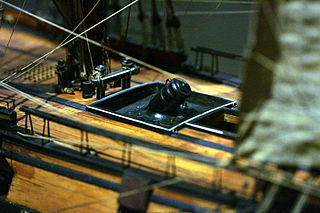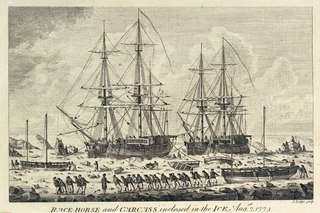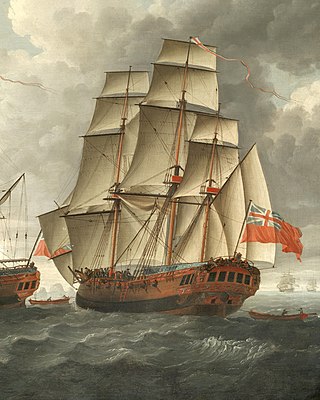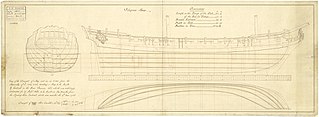
In the 18th century and most of the 19th, a sloop-of-war in the Royal Navy was a warship with a single gun deck that carried up to eighteen guns. The rating system covered all vessels with 20 guns and above; thus, the term sloop-of-war encompassed all the unrated combat vessels, including the very small gun-brigs and cutters. In technical terms, even the more specialised bomb vessels and fireships were classed as sloops-of-war, and in practice these were employed in the sloop role when not carrying out their specialised functions.

A bomb vessel, bomb ship, bomb ketch, or simply bomb was a type of wooden sailing naval ship. Its primary armament was not cannons – although bomb vessels carried a few cannons for self-defence – but mortars mounted forward near the bow and elevated to a high angle, and projecting their fire in a ballistic arc. Explosive shells or carcasses were employed rather than solid shot. Bomb vessels were specialized ships designed for bombarding fixed positions on land. In the 20th century, this naval gunfire support role was carried out by the most similar purpose-built World War I- and II-era monitors, but also by other warships now firing long-range explosive shells.

HMS Carcass was an Infernal-class bomb vessel of the Royal Navy, later refitted as a survey vessel. A young Horatio Nelson served aboard her as a midshipman on an expedition to the Arctic in 1773.

HMS Brilliant was a 36-gun Venus-class fifth-rate frigate of the British Royal Navy that saw active service during the Seven Years' War with France. She performed well against the French Navy in the 1760 Battle of Bishops Court and the 1761 Battle of Cape Finisterre, but was less capable when deployed for bombardment duty off enemy ports. She also captured eight French privateers and sank two more during her six years at sea. The Royal Navy decommissioned Brilliant in 1763. The Navy sold her in 1776 and she became an East Indiaman for the British East India Company (EIC). Brilliant was wrecked in August 1782 on the Comoro Islands while transporting troops to India.

HMS Active was a 28-gun Coventry-class sixth-rate sailing frigate of the Royal Navy, launched in 1758. She was one of the captors of the Spanish ship Hermione. After Hermione surrendered, her captors found that she carried a large cargo of gold and silver that would lead to the greatest single amount of prize money awarded to the crew of a British warship.

HMS Aquilon was a 28-gun Coventry-class sixth-rate frigate of the Royal Navy. Launched in 1758, she saw active service against the French during the Seven Years' War, capturing seven enemy vessels in the first eight months of 1761. She was declared surplus to Navy requirements and sold into private hands in 1776.
HMS Drake was an 8-gun snow-rigged sloop of the Royal Navy, launched in 1741 as the first of three Drake class sloops constructed for convoy duty during the Anglo-Spanish War of Jenkins' Ear from 1739 to 1742. After limited service off the Channel Islands, she was sailed to Gibraltar where she was wrecked in 1742 while under the temporary command of her first lieutenant.

HMS Trial or Tryall was a 10-gun two-masted Hind-class sloop of the Royal Navy, designed by Joseph Allin and built by him at Deptford Dockyard on the Thames River, England. She was launched on 17 July 1744. She and her sister ship, Jamaica, were the only sloops to be built in the Royal Dockyards between 1733 and 1748.
The Bonetta group was a batch of eight 200-ton sloops of wooden construction built for the Royal Navy during 1732. They followed on two sloops built a year earlier. Seven were ordered on 4 May 1732 to a common specification prepared by Jacob Acworth, the Surveyor of the Navy. An additional vessel – Trial – was re-ordered on 6 July to be built to the same specification. The actual individual design was left up to the Master Shipwright in each Royal Dockyard at which they were built. All the draughts were approved by the Navy Board on 28 June 1732.
HMS Hawk was an eight-gun snow-rigged sloop of the Royal Navy, the second of three Drake class sloops constructed during the Anglo-Spanish War of Jenkins' Ear. Launched in 1741, her principal service was as convoy escort and patrol in the Irish Sea. She was broken up at Deptford Dockyard in 1747.
HMS Swift was an 8-gun snow-rigged sloop of the Royal Navy, the last of three Drake class sloops constructed during the Anglo-Spanish War of Jenkins' Ear. Launched in 1741, her principal service was as convoy escort and patrol off North Carolina and in the North Sea. She was lost at sea on 31 October 1756.

HMS Wolf was a 14-gun snow-rigged sloop of the Royal Navy, launched in 1742 as the first of three Wolf-class sloops constructed for action against Spanish privateers during the War of Jenkins' Ear.
HMS Basilisk was a Serpent-class bomb vessel of the Royal Navy, one of ten such vessels commissioned in 1695 to support land assaults on continental ports. Initially commissioned as part of Admiral John Berkeley's fleet during the Nine Years' War, she also saw service as an exploratory vessel along the St Lawrence River, and later as part of the victorious British forces at the Battle of Cape Passaro.
HMS Endeavour was a 4-gun bomb vessel of the Royal Navy, purchased in 1694 but sold out of service the following year.

HMS Baltimore was a Royal Navy sloop-of-war launched in 1742, designed by and named after Lord Baltimore who at the time was a Lord of the Admiralty.

HMS Stork was a 10-gun Alderney-class sloop of the Royal Navy which saw active service during the Seven Years' War. Launched in 1757, she was assigned to the Navy's Jamaica Station until August 1758 when she was captured by the French. She remained in French hands until being disarmed in 1759 and removed from service in 1760.

HMS Diligence was a 10-gun Alderney-class sloop of the Royal Navy which saw active service during the Seven Years' War and the American Revolutionary War. Launched in 1756, she was a successful privateer hunter off the coast of France before being reassigned to North American waters in 1763. Fifteen years later she was briefly refitted as a receiving ship for press ganged sailors brought into Sheerness Dockyard, before being re-registered in August 1779 as the fireship Comet.

HMS Happy was an 8-gun sloop of war of the Royal Navy, launched in 1754 and in active service during the Seven Years' War.

HMS Swallow was a 14-gun Merlin-class sloop of the Royal Navy. Commissioned in 1745, she initially served in home waters as a convoy escort and cruiser before sailing to join the East Indies Station in 1747. There she served in the squadron of Rear-Admiral Edward Boscawen, taking part in an aborted invasion of Mauritius and the Siege of Pondicherry. In 1755 Swallow returned home to join the Downs Station, as part of which she fought at the Raid on St Malo, Raid on Cherbourg, and Battle of Saint Cast in 1758. She was also present when the French fleet broke out of Brest prior to the Battle of Quiberon Bay in 1759.











